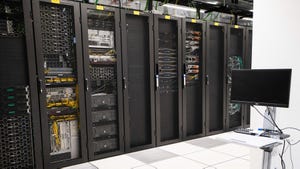The Iceotope Liquid Cooling System in ActionThe Iceotope Liquid Cooling System in Action
Iceotope has moved from the show floor to the lab. The UK company has developed a liquid cooling system that encapsulates servers in heat pipe modules containing 3M’s Novec fluid as its heat removal medium, and now has a system running in the lab at the University of Leeds.
March 4, 2013

Iceotope has moved from the show floor to the lab. The UK cooling company, which launched in 2009, has developed a liquid cooling system that encapsulates servers in heat pipe modules containing 3M’s Novec fluid as its heat removal medium. Last March we provided an update on the company's demo at the Cebit trade show, and a year later the company has a system running in the lab at the University of Leeds.
The company makes some attention-getting claims about its liquid cooling technology, claiming it can reduces data center cooling costs by 97 percent, IT power load by 20 percent and overall infrastructure costs by 50 percent. But Iceotope has advanced slowly since its debut at the SC09 conference, testing its technology at the Universty of Sheffield and now at the University of Leeds, which said this week that it has got its the first Iceotope production system installed after two years of testing prototypes.
In Iceotope's approach, each server motherboard is completely immersed in a sealed bath of liquid coolant which passively transfers heat away from the electronics to a heat exchanger formed by the wall of the module, where water is continuously re-circulated by low-power pumps. The system is nearly silent and requires no cooling outside the cabinet, which in theory would allow data center operators to eliminate expensive room-level cooling schemes. Iceotope says its system uses just 80 watts of power to harvest the heat from up to 20 kilowatts of IT equipment.
"The fact that this system is completely enclosed raises a host of possibilities," said Dr. Nikil Kapur, also from the University of Leeds’ School of Mechanical Engineering. "It does not interact with its environment in the way an air-cooled server does, so you could put it in an extreme environment like the desert. It is also completely silent. You could have it on a submarine or in a classroom."
"Extraordinary Stuff"
"The liquid we are using is extraordinary stuff," said Dr. Jon Summers, Kapur's colleague at the University of Leeds. "You could throw your mobile phone in a tub of it and the phone would work perfectly. But the important thing for the future of computing and the Internet is that it is more than 1,000 times more effective at carrying heat than air."
Iceotope uses Novec, a non-conductive chemical with a very low boiling point, which easily condenses from gas back to liquid. It's made by 3M, which is also developing its own immersion cooling technology around Novec. That technology, known as "open bath immersion cooling," is in the early stages of commercialization. But another liquid cooling vendor, Green Revolution Cooling, has placed several installations in production and is working with Intel to adapt motherboards for its immersion cooling systems.
Iceotope executives say they are pleased with their progress and see big things ahead for the technology.
“More than five years of research, innovation and collaboration have gone into Iceotope’s technology," said Peter Hopton, Iceotope’s Chief Technology Officer. "The basic principle of the design has many applications and, while a few years away, there is no reason why every home shouldn't make better use of the surplus heat from consumer electronics, imagine having your PC or TV plumbed into the central heating system."
About the Author
You May Also Like







